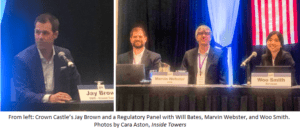Left to Right: J.R. Adams, Doug Jones, Eric Dickerson, Ryan Harper, Jason Sanderson (Back row Willie Goldman).
The 8th Annual South Wireless Summit (SWS) blasted off, literally, Monday afternoon in Nashville, TN, with the Annual Clay Shoot at the Nashville Gun club sponsored by Drake Lighting. Conference attendees ‘locked and loaded’ for the event that challenged experienced and novice shooters alike. A Drake Lighting representative said the shoot was a major success and the best turnout they’ve seen in the eight years since its inception.
Yesterday, the summit panels opened to a full house with industry insights from NATE Executive Director Todd Schlekeway, who discussed the top challenges that the industry is facing from a contractor perspective. The primary issues that could hinder 5G deployment, according to Schlekeway, were worker shortage and payment term extension. He told the audience that NATE has been targeting millennials with their online marketing campaigns and Climber Conversation videos, aimed to educate the younger generation about the tower industry’s job opportunities. In addition, they are covering all the bases by staying involved with telecom related legislation by organizing the NATE Fly-In, NATE WIN, work with Warriors4Wireless, and the National Wireless Safety Alliance.
It was standing room only for the keynote delivered by Jay Brown, CEO of Crown Castle. Brown discussed how the industry and workforce has changed during his 20 years at Crown. Brown said when he started working at Crown Castle, a significant portion of their income was from paging companies, and now, “the millennials being recruited out of college often don’t know what a pager is.”
“The big move is going to be a reduction in latency,” Brown said, “which results in nearly instantaneous responses from the devices and an ability to greatly increase the number of connections inside of the network.”
Brown said he see macro towers continuing to play an important role in the next generation of wireless deployments, as the most cost effective way for a company to deploy wireless spectrum.
“Even around the edges,” he said, “some of the non traditional owners of spectrum and deployers of wireless networks, I think are likely to first use the existing towers as a means of deployment, the backbone of the network, and then increasingly, I think you will see fiber connected small cells used to improve both coverage of the network as well as density of the network,” Brown said. He cited NFL cities as an example for the increasing need for cell coverage density and “cell splitting.”
“The emphasis and allocation of capital that’s coming from small cells I think is going to be a pretty dramatic change to our overall industry from what it has been historically,” Brown said. “That’s not to say there isn’t still opportunity and growth in the tower industry, but I think if you look at the total allocation of dollars put into the industry over the next twenty years, there is going to be a significant portion of those dollars that are going to be invested into small cells.”
A regulatory update session followed Brown. It included Woo Smith, Terracon, Marvin Webster, ECA and Will Bates, Tri-Leaf, and was moderated by Craig Thieman, KWA President. The panel discussed the changes that have taken place in the FCC regulatory landscape in the last year.
Some of the positive changes that have occurred recently according to the panel, were small cell deregulation and tribal consultation changes, such as the elimination of upfront tribal fees, limitations as to what tribes can ask for when beginning consultation and a response timeline. Additional improvements centered around environmental assessments removed for floodplains and a 60-day shot-clock imposed by the FCC when reviewing EAs.
“Applicants are making great use of the small cell deregulation by designing with exclusions in mind to avoid NEPA,” Woo Smith said. While FCC review timelines have been shortened, Smith said most of this can be attributed to the removal of floodplain assessment which was 95 percent of submitted Environmental Assessments and standardization claims. But, Smith said, tribal nations are not happy about the elimination of tribal fees and are resisting the streamlined process.
“Tribal challenges have put a definite strain on the consultant/tribe working relationship that has taken years to build,” she said. Woo said the FCC has yet to implement some simple solutions to their online portals specifically in regards to the tribal referral process.
“In all, FCC timelines have improved but the government shutdown did cause some delays and there are still some delays caused by the lack of a shot clock for dispute resolutions within the FCC,” Smith said.
A touching memorial video was also shared yesterday. If you missed it, it can be viewed here.
By Cara Aston for Inside Towers
March 20, 2019






Reader Interactions